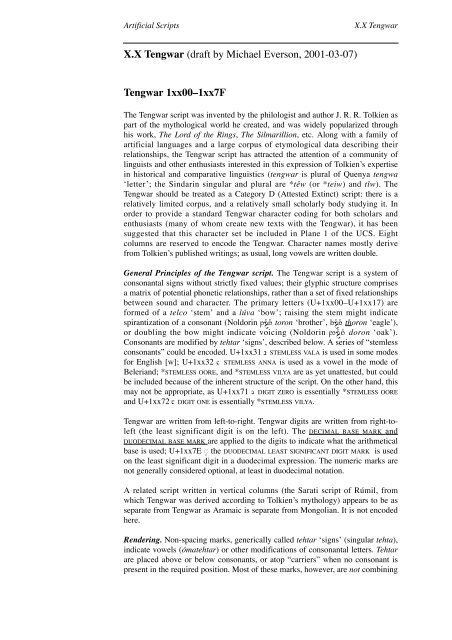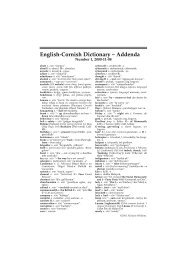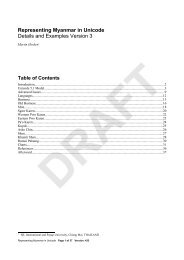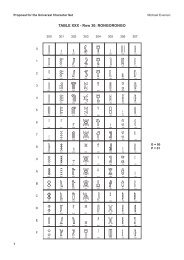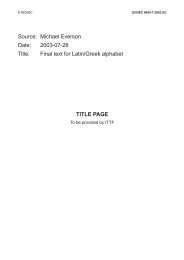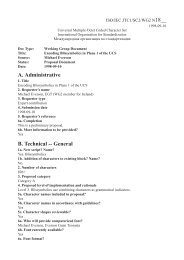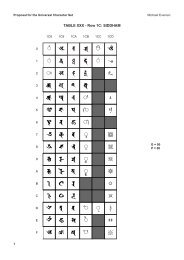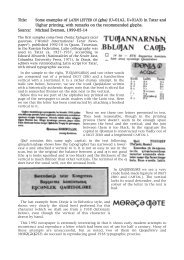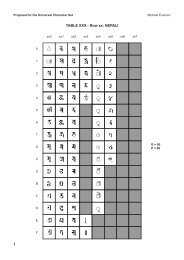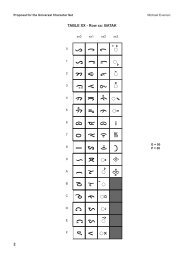X.X Tengwar (draft by Michael Everson, 2001-03-07 ... - Evertype
X.X Tengwar (draft by Michael Everson, 2001-03-07 ... - Evertype
X.X Tengwar (draft by Michael Everson, 2001-03-07 ... - Evertype
You also want an ePaper? Increase the reach of your titles
YUMPU automatically turns print PDFs into web optimized ePapers that Google loves.
Artificial Scripts X.X <strong>Tengwar</strong><br />
X.X <strong>Tengwar</strong> (<strong>draft</strong> <strong>by</strong> <strong>Michael</strong> <strong>Everson</strong>, <strong>2001</strong>-<strong>03</strong>-<strong>07</strong>)<br />
<strong>Tengwar</strong> 1xx00–1xx7F<br />
The <strong>Tengwar</strong> script was invented <strong>by</strong> the philologist and author J. R. R. Tolkien as<br />
part of the mythological world he created, and was widely popularized through<br />
his work, The Lord of the Rings, The Silmarillion, etc. Along with a family of<br />
artificial languages and a large corpus of etymological data describing their<br />
relationships, the <strong>Tengwar</strong> script has attracted the attention of a community of<br />
linguists and other enthusiasts interested in this expression of Tolkien’s expertise<br />
in historical and comparative linguistics (tengwar is plural of Quenya tengwa<br />
‘letter’; the Sindarin singular and plural are *têw (or *teiw) and tîw). The<br />
<strong>Tengwar</strong> should be treated as a Category D (Attested Extinct) script: there is a<br />
relatively limited corpus, and a relatively small scholarly body studying it. In<br />
order to provide a standard <strong>Tengwar</strong> character coding for both scholars and<br />
enthusiasts (many of whom create new texts with the <strong>Tengwar</strong>), it has been<br />
suggested that this character set be included in Plane 1 of the UCS. Eight<br />
columns are reserved to encode the <strong>Tengwar</strong>. Character names mostly derive<br />
from Tolkien’s published writings; as usual, long vowels are written double.<br />
General Principles of the <strong>Tengwar</strong> script. The <strong>Tengwar</strong> script is a system of<br />
consonantal signs without strictly fixed values; their glyphic structure comprises<br />
a matrix of potential phonetic relationships, rather than a set of fixed relationships<br />
between sound and character. The primary letters (U+1xx00–U+1xx17) are<br />
formed of a telco ‘stem’ and a lúva ‘bow’; raising the stem might indicate<br />
spirantization of a consonant (Noldorin Ć~î~ toron ‘brother’, à†~î~ thoron ‘eagle’),<br />
or doubling the bow might indicate voicing (Noldorin ц~î~ doron ‘oak’).<br />
Consonants are modified <strong>by</strong> tehtar ‘signs’, described below. A series of “stemless<br />
consonants” could be encoded. U+1xx31 ± STEMLESS VALA is used in some modes<br />
for English [w]; U+1xx32 ≤ STEMLESS ANNA is used as a vowel in the mode of<br />
Beleriand; *STEMLESS OORE, and *STEMLESS VILYA are as yet unattested, but could<br />
be included because of the inherent structure of the script. On the other hand, this<br />
may not be appropriate, as U+1xx71 apple DIGIT ZERO is essentially *STEMLESS OORE<br />
and U+1xx72 Ò DIGIT ONE is essentially *STEMLESS VILYA.<br />
<strong>Tengwar</strong> are written from left-to-right. <strong>Tengwar</strong> digits are written from right-toleft<br />
(the least significant digit is on the left). The DECIMAL BASE MARK and<br />
DUODECIMAL BASE MARK are applied to the digits to indicate what the arithmetical<br />
base is used; U+1xx7E ˇ˝ the DUODECIMAL LEAST SIGNIFICANT DIGIT MARK is used<br />
on the least significant digit in a duodecimal expression. The numeric marks are<br />
not generally considered optional, at least in duodecimal notation.<br />
A related script written in vertical columns (the Sarati script of Rúmil, from<br />
which <strong>Tengwar</strong> was derived according to Tolkien’s mythology) appears to be as<br />
separate from <strong>Tengwar</strong> as Aramaic is separate from Mongolian. It is not encoded<br />
here.<br />
Rendering. Non-spacing marks, generically called tehtar ‘signs’ (singular tehta),<br />
indicate vowels (ómatehtar) or other modifications of consonantal letters. Tehtar<br />
are placed above or below consonants, or atop “carriers” when no consonant is<br />
present in the required position. Most of these marks, however, are not combining
X.X <strong>Tengwar</strong> Artificial Scripts<br />
characters, because it cannot be said that they should always follow the character<br />
to which they are applied, if logical (phonetic) order is to be applied to this script.<br />
The morphological structure of a language determines the “mode” in which the<br />
<strong>Tengwar</strong> script is used for it. For instance, the tehtar are placed above or below<br />
the preceding consonant in languages in which words tend to end in a vowel (i.e.<br />
with a CV structure); but they are placed above or below the following consonant<br />
in languages in which words tend to end in a consonant (i.e. with a CVC<br />
structure). Compare Quenya ê∆£∆ nelde ‘three’, ê∆¢Äƒ£ƒ neltildi ‘triangle’ with<br />
Sindarin ê¢∆Ñ∆ neled ‘three’ and ê¢∆ࢃ nelthil ‘triangle’. English is generally<br />
written according to a Sindarin-type mode; Japanese would be written according<br />
to a Quenya-type mode.<br />
<strong>Tengwar</strong> shaping behaviour is considered to be similar to that of Arabic, in that<br />
certain sequences of characters combine automatically to produce certain glyphs.<br />
Fonts must be identified as pertaining to one of the two modes. In a Quenya font,<br />
the sequence §ƒ¢ë¿†ƒ¢— ƒÆ~ê S i<br />
LM a<br />
R i i<br />
LX ˜<br />
o<br />
N will be read silmarillion (the same sequence<br />
would be read *islammirllionn in Sindarin). In a Sindarin font, the sequence<br />
§¢ƒë†¿¢— ƒÆƒê~ SL i<br />
MR a i<br />
X i<br />
N o<br />
will be read silmarillion (a sequence which would be read<br />
L ˜<br />
*slimralli-ino in Quenya). Note, however, that in both cases the underlying<br />
encoding is the same: § + ƒ + ¢ + ë + ¿ + † + ƒ + ¢ + ˇ— + ƒ + Æ + ~ + ê<br />
SILMARIL ˜ IXON. It is only that the glyph sequences selected are<br />
[SI][L][MA][RI][L ˜ I][XO][N] in the Quenya font but [S][IL][M][AR][IL ˜ ][IX][ON] in the<br />
Sindarin font (X is used here to show the vowel carrier).<br />
In the mode of Beleriand, the tehtar are not generally used to indicate vowels.<br />
Instead, individual tengwar represent them. In this mode, §Æ¢ï≤†Æ¢—Ƶî<br />
silmarillion is written just as presented: [S][I][L][M][A][R][I][L ˜ ][I][O][N]. Note that<br />
the DOUBLER of ¢— L ˜ ll is a true combining character here as above in the Quenya<br />
and Sindarin modes.<br />
True ligatures also occur in <strong>Tengwar</strong>; these should be represented with the<br />
U+200D ZERO-WIDTH JOINER in plain text. Examples (in a Sindarin-mode font):<br />
Old English 뺃 êà mihton ‘might’ (ë + ƒ + ä + ZWJ + Ä + à + ê), Old English<br />
æîÃÄ scort ‘short’ (§ + ZWJ + ä + à + î + Ä), Old English †¨¬ª weox ‘grew’ († + ¬ +<br />
¨ + É + ZWJ + §), English §É¢~ø¿ skolars ‘scholars’ (§ + É + ~ + ¢ + ¿ + î + ZWJ +<br />
§).<br />
Ligation may also occur with tengwar and tehtar in certain instances. In one<br />
mode for Old English, the vowel preceding a consonant is written above it, and<br />
following a consonant is written after it: àî¿√ ære ‘of it’. This should, in a<br />
Sindarin font, use ZERO-WIDTH JOINER to force the link between the last two letters<br />
(otherwise àî¿ √ will result. This is coded à + ¿ + î + ZWJ + √.<br />
Spelling variants<br />
A certain variation in spelling can occur, but the model remains sound. For the<br />
word English animal, the following spellings would obtain:<br />
Roman <strong>Tengwar</strong> Representation Cursive glyphs (mode)<br />
animal Æ¿êƒë¿¢ Æ + ¿ + ê + ƒ + ë + ¿ + ¢ [XA][NI][MA][L] (Quenya)<br />
animal î¿ïƒ¢¿ ¿ + î + ƒ + ï + ¿ + ¢ [AN][IM][AL] (Sindarin)<br />
animal ∞îÆï∞¢ ≤ + î + Æ + ï + ≤ + ¢ [A][N][I][M][A][L] (either)
Artificial Scripts X.X <strong>Tengwar</strong><br />
For some lexical purposes the variation would have to be taken into account,<br />
though this is not much different from what has to be done in English with<br />
spellings like façade/facade, colour/color, or æsthetic/aesthetic/esthetic.<br />
In the mode of Beleriand, “a dot is sometimes placed over ∞ and Æ to mark these<br />
as separate letters, and not a curl or a stem belonging to an adjacent letter” (Krieg<br />
1978). Examples are ≤ƒÜ¢≤† aglar ‘glory’ and î≤ƒä≤†Ñ nachaered ‘to a remote<br />
distance’ (in the second example the dot shows that ≤ƒä is ach rather than é gh).<br />
The true combining character U+<strong>03</strong><strong>07</strong> COMBINING DOT ABOVE should be used for<br />
these instances. Likewise, when in the mode of Beleriand the acute is used atop a<br />
tengwa used as a vowel, the combining character U+<strong>03</strong>01 COMBINING ACUTE<br />
ACCENT should be used. It is only when a tehta is vocalic that the cursivity model<br />
applies. The user has to know which of the dots applies.<br />
Punctuation. <strong>Tengwar</strong> punctuation characters are considered to be unique to the<br />
script and are coded in the <strong>Tengwar</strong> block. Some composition of punctuation<br />
occurs in <strong>Tengwar</strong>. The following combinations are attested:<br />
. FULL STOP<br />
‡ PUSTA<br />
· DOUBLE PUSTA<br />
·‡ DOUBLE PUSTA+ PUSTA<br />
·· DOUBLE PUSTA + DOUBLE PUSTA<br />
·Ë DOUBLE PUSTA+ SECTION MARK<br />
·È DOUBLE PUSTA+ DOUBLE SECTION MARK<br />
‚ TRIPLE PUSTA<br />
„ QUADRUPLE PUSTA (not ‡·‡ PUSTA + DOUBLE PUSTA + PUSTA)<br />
‰ QUINTUPLE PUSTA (not ‡‚‡ PUSTA + TRIPLE PUSTA + PUSTA)<br />
 EXCLAMATION MARK<br />
‡ EXCLAMATION MARK + PUSTA<br />
Ê ·· QUESTION MARK + SPACE + DOUBLE PUSTA + DOUBLE PUSTA<br />
Sometimes word space is not used; word separation may be achieved in that case<br />
with U+200B, ZERO-WIDTH SPACE. Hyphens are not used at linebreaks; words may<br />
be broken before any syllable. One has to know the language to know where the<br />
syllable boundaries are.<br />
The SHORT CARRIER Æ simply bears the vowel tehta; the LONG CARRIER ¨ indicates<br />
that the vowel is long; this can also be done <strong>by</strong> doubling the vowel sign (so Æ∆ = e,<br />
¨∆ = ê, Æ» = ê). In Quenya fonts, these are coded ¨ + ∆, etc.; in Sindarin fonts, they<br />
are coded ∆ + ¨, etc.<br />
Sources for characters<br />
The characters in this proposal are attested (explicitly or in technical description)<br />
in the following sources. Page numbers follow the UCS code positions given.<br />
Tolkien 1965a<br />
xx53:6<br />
Tolkien 1965b<br />
xx67:59<br />
Tolkien 1965c<br />
xx30:319, xx32:319<br />
Tolkien 1965d
X.X <strong>Tengwar</strong> Artificial Scripts<br />
xx00:396, xx01:396, xx02:396, xx<strong>03</strong>:396, xx04:396, xx05:396, xx06:396, xx<strong>07</strong>:396,<br />
xx08:396, xx09:396, xx0A:396, xx0B:396, xx0C:396, xx0D:396, xx0E:396,<br />
xx0F:396, xx10:396, xx11:396, xx12:396, xx13:396, xx14:396, xx15:396, xx16:396,<br />
xx17:396, xx18:398, xx19:398, xx1A:398, xx1B:398, xx1C:398, xx1D:398,<br />
xx1E:398, xx1F:398, xx20:396, xx21:396, xx22:396, xx23:396, xx24:396, xx25:396,<br />
xx26:396, xx27:396, xx28:396, xx29:396, xx2A:396, xx2B:396, xx2C:400,<br />
xx2D:401, xx2E:399, xx42:400, xx45:400, xx4E:400, xx4F:400, xx50:400<br />
Tolkien & Swann 1967<br />
xx40:v, xx43:v, xx44:v, xx46:v, xx48:v, xx4A:v, xx4C:v, xx51:v, xx60:v, xx61:ix,<br />
xx63:vi, xx64:vi<br />
Tolkien 1977<br />
xx35:4, xx4B:4<br />
Tolkien 1989<br />
xx34:ii<br />
Tolkien 1992 (pictures)<br />
xx31, xx36<br />
Tolkien 1992a (epilogue Sauron defeated)<br />
xx55, xx62, xx65<br />
Tolkien 1992b (notion club Sauron defeated)<br />
xx41:326, xx49:325, xx4D:326, xx52:324,. xx57:326<br />
Used positions (not yet sourced)<br />
xx2F<br />
xx33, xx37<br />
xx54, xx56,<br />
xx66, xx68<br />
xx70, xx71, xx72,. xx73, xx74, xx75, xx76, xx77, xx78, xx79, xx7A, xx7B, xx7C,<br />
xx7D<br />
Unused positions:<br />
xx38, xx39, xx3A, xx3B, xx3C, xx3D, xx3E, xx3F, xx47, xx58, xx59, xx5A, xx5B,<br />
xx5C, xx5D, xx5E, xx5F, xx69, xx6A, xx6B, xx6C, xx6D, xx6E, xx6F, xx7E, xx7F<br />
Encoding Structure (This needs to be revised when the code table is fixed)<br />
The <strong>Tengwar</strong> block is divided into the following ranges:<br />
U+xx01 -> xx3E <strong>Tengwar</strong><br />
U+xx2E -> xx30 unassigned<br />
U+xx31 -> xx32 <strong>Tengwar</strong><br />
U+xx33 unassigned<br />
U+xx34 -> xx39 <strong>Tengwar</strong><br />
U+xx3A -> xx3F unassigned<br />
U+xx40 -> xx46 Tehtar<br />
U+xx47 unassigned<br />
U+xx48 -> xx57 Tehtar<br />
U+xx58 -> xx5F unassigned<br />
U+xx60 -> xx68 Punctuation<br />
U+xx69 -> xx6F unassigned<br />
U+xx70 -> xx7D Digits<br />
U+xx7E Numeric modifiers<br />
U+xx7F unassigned
Artificial Scripts X.X <strong>Tengwar</strong><br />
Unicode Character Properties<br />
(These have not been sorted out yet.)<br />
Spacing letters, category “Lo”, bidi category “L” (strong left to right)<br />
xx00–xx37, xx40–xx46, xx48–xx4F, xx52–xx54<br />
Non-spacing marks, category “Mn”, bidi category “ON” (other neutral);<br />
combining priorities in parentheses:<br />
xx50-xx51, xx55–xx57, xx7D (xxxxxxx)<br />
Symbols, category “Po”, bidi category “L” (strong left to right)<br />
xx60–xx68<br />
Numbers, category “Po”, bidi category “R” (strong right to left)<br />
xx70–xx7C<br />
References<br />
Krieg, Lawrence J. 1978. “The <strong>Tengwar</strong> of Fëanor”, in Jim Allan, ed. An<br />
introduction to Elvish. Frome: Bran’s Head. Pp. 236–XX.<br />
Tolkien, Christopher. 1992a. “The Epilogue” in Sauron defeated. (The History of<br />
Middle Earth; 9) London: HarperCollins. Pp. 114-135. ISBN 0-261-10240-0<br />
Tolkien, Christopher. 1992b. Notes to “The Notion Club Papers (Part Two)” in<br />
Sauron defeated. (The History of Middle Earth; 9) London: HarperCollins. Pp.<br />
3<strong>07</strong>-327. ISBN 0-261-10240-0<br />
Tolkien, J. R. R. 1965a. Title page to The Fellowship of the Ring. Boston:<br />
Houghton Mifflin. ISBN 0-395-08254-4<br />
Tolkien, J. R. R. 1965b. “The Ring inscription”, in The Fellowship of the Ring.<br />
Boston: Houghton Mifflin. P. 59. ISBN 0-395-08254-4<br />
Tolkien, J. R. R. 1965c. “The West-Gate inscription”, in The Fellowship of the<br />
Ring. Boston: Houghton Mifflin. P. 319. ISBN 0-395-08254-4<br />
Tolkien, J. R. R. 1965d. “Appendix E: Writing and spelling” in The return of the<br />
King. Boston: Houghton Mifflin. Pp. 391-404. ISBN 0-395-08256-0<br />
Tolkien, J. R. R., and Donald Swann. 1967. The road goes ever on: a song cycle.<br />
Boston: Houghton Mifflin. ISBN 0-395-08258-7<br />
Tolkien, J. R. R. 1977. Title page to The Silmarillion. Boston: Houghton Mifflin.<br />
ISBN 0-395-25730-1<br />
Tolkien, J. R. R. 1989. Title page to The Lost Road and other writings. London:<br />
Unwin Paperbacks. (The History of Middle Earth; 5) ISBN 0-04-44<strong>03</strong>98-4<br />
Tolkien, J. R. R. 1992. Pictures <strong>by</strong> J. R. R. Tolkien. London: HarperCollins. Plate<br />
48. ISBN 0-261-10258-3<br />
Tolkien, J. R. R. 19XX. “SXXX” in The Return of the King. Boston: Houghton<br />
Mifflin.
X.X <strong>Tengwar</strong> Artificial Scripts<br />
Annex A. Discussion of the <strong>Tengwar</strong> number system.
Proposal for the Universal Character Set <strong>Michael</strong> <strong>Everson</strong><br />
2<br />
0<br />
1<br />
2<br />
3<br />
4<br />
5<br />
6<br />
7<br />
8<br />
9<br />
A<br />
B<br />
C<br />
D<br />
E<br />
F<br />
TABLE XX - Row xx: TENGWAR<br />
xx0 xx1 xx2 xx3 xx4 xx5 xx6 xx7<br />
Ä ê † ∞ ¿ ˇ– ‡ apple<br />
Å ë ° ± ¡ ˇ— · Ò<br />
Ç í ¢ ≤ ¬ “ ‚ Ú<br />
É ì £ ≥ √ ” „ Û<br />
Ñ î § ¥ ƒ ‘ ‰ Ù<br />
Ö ï • µ ≈ ˇ’ Â ı<br />
Ü ñ ∂ ∆ ˇ÷ Ê ˆ<br />
á ó ß ∑ « ˇ◊ Á ˜<br />
à ò ® ∏ » ÿ Ë ¯<br />
â ô © π … È ˘<br />
ä ö ∫ ~ ⁄ ˙<br />
ã õ ´ À ˚<br />
å ú ¨ Ã ‹ ¸<br />
ç ù ≠ Õ › ˇ˝<br />
Œ<br />
œ<br />
é û Æ<br />
è ü<br />
G = 00<br />
P = 01
<strong>Michael</strong> <strong>Everson</strong> Proposal for the Universal Character Set<br />
dec<br />
000<br />
001<br />
002<br />
0<strong>03</strong><br />
004<br />
005<br />
006<br />
0<strong>07</strong><br />
008<br />
009<br />
010<br />
011<br />
012<br />
013<br />
014<br />
015<br />
016<br />
017<br />
018<br />
019<br />
020<br />
021<br />
022<br />
023<br />
024<br />
025<br />
026<br />
027<br />
028<br />
029<br />
<strong>03</strong>0<br />
<strong>03</strong>1<br />
<strong>03</strong>2<br />
<strong>03</strong>3<br />
<strong>03</strong>4<br />
<strong>03</strong>5<br />
<strong>03</strong>6<br />
<strong>03</strong>7<br />
<strong>03</strong>8<br />
<strong>03</strong>9<br />
040<br />
041<br />
042<br />
043<br />
044<br />
045<br />
046<br />
047<br />
048<br />
049<br />
050<br />
051<br />
052<br />
053<br />
054<br />
055<br />
056<br />
057<br />
058<br />
059<br />
060<br />
061<br />
062<br />
063<br />
064<br />
065<br />
066<br />
067<br />
068<br />
069<br />
<strong>07</strong>0<br />
<strong>07</strong>1<br />
<strong>07</strong>2<br />
<strong>07</strong>3<br />
<strong>07</strong>4<br />
<strong>07</strong>5<br />
<strong>07</strong>6<br />
<strong>07</strong>7<br />
<strong>07</strong>8<br />
<strong>07</strong>9<br />
080<br />
081<br />
082<br />
083<br />
084<br />
085<br />
086<br />
087<br />
088<br />
hex<br />
00<br />
01<br />
02<br />
<strong>03</strong><br />
04<br />
05<br />
06<br />
<strong>07</strong><br />
08<br />
09<br />
0A<br />
0B<br />
0C<br />
0D<br />
0E<br />
0F<br />
10<br />
11<br />
12<br />
13<br />
14<br />
15<br />
16<br />
17<br />
18<br />
19<br />
1A<br />
1B<br />
1C<br />
1D<br />
1E<br />
1F<br />
20<br />
21<br />
22<br />
23<br />
24<br />
25<br />
26<br />
27<br />
28<br />
29<br />
2A<br />
2B<br />
2C<br />
2D<br />
2E<br />
2F<br />
30<br />
31<br />
32<br />
33<br />
34<br />
35<br />
36<br />
37<br />
38<br />
39<br />
3A<br />
3B<br />
3C<br />
3D<br />
3E<br />
3F<br />
40<br />
41<br />
42<br />
43<br />
44<br />
45<br />
46<br />
47<br />
48<br />
49<br />
4A<br />
4B<br />
4C<br />
4D<br />
4E<br />
4F<br />
50<br />
51<br />
52<br />
53<br />
54<br />
55<br />
56<br />
57<br />
58<br />
Name<br />
TENGWAR LETTER TINCO<br />
TENGWAR LETTER PARMA<br />
TENGWAR LETTER CALMA<br />
TENGWAR LETTER QUESSE<br />
TENGWAR LETTER ANDO<br />
TENGWAR LETTER UMBAR<br />
TENGWAR LETTER ANGA<br />
TENGWAR LETTER UNGWE<br />
TENGWAR LETTER THUULE (suule)<br />
TENGWAR LETTER FORMEN<br />
TENGWAR LETTER HARMA (aha)<br />
TENGWAR LETTER HWESTA<br />
TENGWAR LETTER ANTO<br />
TENGWAR LETTER AMPA<br />
TENGWAR LETTER ANCA<br />
TENGWAR LETTER UNQUE<br />
TENGWAR LETTER NUUMEN<br />
TENGWAR LETTER MALTA<br />
TENGWAR LETTER NOLDO (ngoldo)<br />
TENGWAR LETTER NWALME (ngwalme)<br />
TENGWAR LETTER OORE<br />
TENGWAR LETTER VALA<br />
TENGWAR LETTER ANNA<br />
TENGWAR LETTER VILYA (wilya)<br />
TENGWAR LETTER EXTENDED TINCO<br />
TENGWAR LETTER EXTENDED PARMA<br />
TENGWAR LETTER EXTENDED CALMA<br />
TENGWAR LETTER EXTENDED QUESSE<br />
TENGWAR LETTER EXTENDED ANDO<br />
TENGWAR LETTER EXTENDED UMBAR<br />
TENGWAR LETTER EXTENDED ANGA<br />
TENGWAR LETTER EXTENDED UNGUE<br />
TENGWAR LETTER ROOMEN<br />
TENGWAR LETTER ARDA<br />
TENGWAR LETTER LAMBE<br />
TENGWAR LETTER ALDA<br />
TENGWAR LETTER SILME<br />
TENGWAR LETTER SILME NUQUERNA<br />
TENGWAR LETTER AARE (aaze, esse)<br />
TENGWAR LETTER AARE NUQUERNA (aaze n., esse n.)<br />
TENGWAR LETTER HYARMEN<br />
TENGWAR LETTER HWESTA SINDARINWA<br />
TENGWAR LETTER YANTA<br />
TENGWAR LETTER UURE<br />
TENGWAR LETTER LONG CARRIER<br />
TENGWAR LETTER HALLA<br />
TENGWAR LETTER SHORT CARRIER<br />
(This position shall not be used)<br />
(This position shall not be used)<br />
TENGWAR LETTER STEMLESS VALA<br />
TENGWAR LETTER STEMLESS ANNA<br />
(This position shall not be used)<br />
TENGWAR LETTER LIGATING SHORT CARRIER<br />
TENGWAR LETTER ANNA SINDARINWA<br />
TENGWAR LETTER OPEN ANNA<br />
TENGWAR LETTER REVERSED PARMA<br />
TENGWAR LETTER REVERSED FORMEN<br />
TENGWAR LETTER TALL STEMLESS VALA<br />
TENGWAR LETTER MH<br />
(This position shall not be used)<br />
(This position shall not be used)<br />
(This position shall not be used)<br />
(This position shall not be used)<br />
(This position shall not be used)<br />
TENGWAR SIGN THREE DOTS ABOVE<br />
TENGWAR SIGN THREE DOTS BELOW<br />
TENGWAR SIGN TWO DOTS ABOVE<br />
TENGWAR SIGN TWO DOTS BELOW<br />
TENGWAR SIGN AMATICSE (dot above)<br />
TENGWAR SIGN NUNTICSE (dot below)<br />
TENGWAR SIGN ACUTE (andaith, long mark)<br />
(This position shall not be used)<br />
TENGWAR SIGN DOUBLE ACUTE<br />
TENGWAR SIGN DOUBLE ACUTE BELOW<br />
TENGWAR SIGN RIGHT CURL<br />
TENGWAR SIGN RIGHT CURL BELOW<br />
TENGWAR SIGN LEFT CURL<br />
TENGWAR SIGN LEFT CURL BELOW<br />
TENGWAR SIGN DOUBLE RIGHT CURL<br />
TENGWAR SIGN DOUBLE LEFT CURL<br />
TENGWAR SIGN NASALIZER<br />
TENGWAR SIGN DOUBLER<br />
TENGWAR SIGN TILDE<br />
TENGWAR SIGN BREVE<br />
TENGWAR SIGN GRAVE<br />
TENGWAR SIGN YANTA ABOVE<br />
TENGWAR SIGN THREE INVERTED DOTS ABOVE<br />
TENGWAR SIGN LONG CARRIER BELOW<br />
(This position shall not be used)<br />
TABLE XX - Row xx: TENGWAR<br />
Group 00 Plane 01 Row 02<br />
3<br />
dec<br />
089<br />
090<br />
091<br />
092<br />
093<br />
094<br />
095<br />
096<br />
097<br />
098<br />
099<br />
100<br />
101<br />
102<br />
1<strong>03</strong><br />
104<br />
105<br />
106<br />
1<strong>07</strong><br />
108<br />
109<br />
110<br />
111<br />
112<br />
113<br />
114<br />
115<br />
116<br />
117<br />
118<br />
119<br />
120<br />
121<br />
122<br />
123<br />
124<br />
125<br />
126<br />
127<br />
hex<br />
59<br />
5A<br />
5B<br />
5C<br />
5D<br />
5E<br />
5F<br />
60<br />
61<br />
62<br />
63<br />
64<br />
65<br />
66<br />
67<br />
68<br />
69<br />
6A<br />
6B<br />
6C<br />
6D<br />
6E<br />
6F<br />
70<br />
71<br />
72<br />
73<br />
74<br />
75<br />
76<br />
77<br />
78<br />
79<br />
7A<br />
7B<br />
7C<br />
7D<br />
7E<br />
7F<br />
Name<br />
(This position shall not be used)<br />
(This position shall not be used)<br />
(This position shall not be used)<br />
(This position shall not be used)<br />
(This position shall not be used)<br />
(This position shall not be used)<br />
(This position shall not be used)<br />
TENGWAR PUSTA (putta, stop)<br />
TENGWAR DOUBLE PUSTA (putta)<br />
TENGWAR TRIPLE PUSTA (putta)<br />
TENGWAR QUADRUPLE PUSTA (putta)<br />
TENGWAR QUINTUPLE PUSTA (putta)<br />
TENGWAR EXCLAMATION MARK<br />
TENGWAR QUESTION MARK<br />
TENGWAR PARENTHESIS MARK<br />
TENGWAR SECTION MARK<br />
TENGWAR DOUBLE SECTION MARK<br />
(This position shall not be used)<br />
(This position shall not be used)<br />
(This position shall not be used)<br />
(This position shall not be used)<br />
(This position shall not be used)<br />
(This position shall not be used)<br />
TENGWAR DIGIT ZERO<br />
TENGWAR DIGIT ONE<br />
TENGWAR DIGIT TWO<br />
TENGWAR DIGIT THREE<br />
TENGWAR DIGIT FOUR<br />
TENGWAR DIGIT FIVE<br />
TENGWAR DIGIT SIX<br />
TENGWAR DIGIT SEVEN<br />
TENGWAR DIGIT EIGHT<br />
TENGWAR DIGIT NINE<br />
TENGWAR DUODECIMAL DIGIT TEN<br />
TENGWAR DUODECIMAL DIGIT ELEVEN<br />
TENGWAR DUODECIMAL DIGIT TWELVE<br />
TENGWAR DUODECIMAL LEAST SIGNIFICANT DIGIT MARK<br />
(This position shall not be used)<br />
(This position shall not be used)


